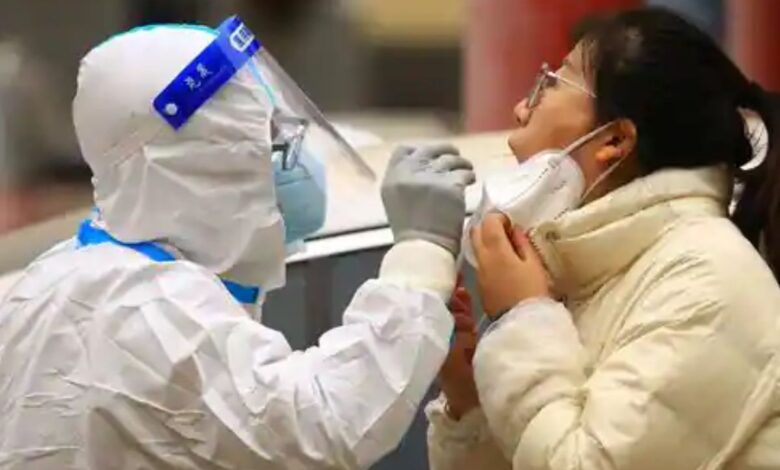A study from China sensors asserts that “5 lakh COVID instances are registered daily in a city.”

In a rare and swiftly suppressed admission that the country’s wave of illnesses is not being represented in official data, a top health official said that half a million individuals in a single Chinese metropolis are becoming contaminated with Covid-19 every day.
In a startling reversal of its illustrious containment approach, China has swiftly destroyed significant components of its zero-Covid plan this month, eliminating sudden lockdowns, protracted quarantines, and travel restrictions.
Rising infection rates have left pharmacy shelves empty and hospital wards full. It appears even crematoriums and funeral houses are seeing backlogs as cities throughout the country battle to keep up.
However, the elimination of stringent testing requirements has made it nearly challenging to track caseloads, and officials have limited the criteria of a Covid death, a move that experts say would reduce the number of deaths connected to the virus.
The municipal health head in Qingdao was quoted as saying on Friday that the eastern metropolis was experiencing “between 490,000 and 530,000” additional Covid instances a day by a Communist Party-run news site.
According to reports, Bo Tao stated that the port city of about ten mn people was “in a phase of fast transmission before of an impending peak” and predicted that the illness percentage would rise by a further 10% over the weekend.
Several other news organizations published the report, but it seemed to have been changed by Saturday morning to remove the case numbers. The previous day saw 4,103 new domestic infections reported nationally, according to China’s National Health Commission, but no more deaths.
The authorities formally reported just 31 domestic cases in Shandong, the county where Qingdao is situated. The Chinese government maintains strict control over the nation’s media, with hordes of internet censors on hand to remove anything judged to be politically sensitive.
The majority of articles produced by the administration understated the intensity of the nation’s exodus wave and instead portrayed the change in policy as rational and planned.
Although predictions of real case numbers are still uncommon, certain media outlets have referenced drug shortages and hospitals under pressure. In a social media post on Friday, the authorities of Jiangxi’s eastern province predicted that by March, 80% of its citizens, or around 36 million people, will be sick.

In the two weeks before Thursday, more than 18,000 Covid customers had been brought to major medical facilities in the province, including roughly 500 severe cases but no fatalities, according to the statement. At the moment, China’s Covid issue is uncontrollably out of control. After the mandated mass testing, the authorities state it is difficult to monitor how quickly the virus is spreading.
In contrast to China’s data sharing, health data company Airfinity believes that more than 5,000 individuals in China are likely dying from COVID-19 every day. The following list of 10 points regarding the present COVID circumstance in China can help you:
- Older people make up most of those who are now getting the virus. Millions of old individuals in China continue to be appropriately immunized, raising worries that the disease may kill many of the country’s most vulnerable inhabitants.
- A major number of people who work in hospitals have come back positive for the disease. According to the news agency AFP, a medic at Chongqing Medical University First Attached Hospital stated, “A lot of hospital employees are hopeful as well, but we have no choice but to continue working.”
- The southern province of Guangdong and Beijing saw the fastest increases in cases recently. In Shanghai, stretchers carrying elderly patients connected to oxygen tanks clogged the hallways of the emergency rooms of hospitals.

- The Shanghai Deji Hospital projected late on Wednesday that there were around 5.43 million positive in the city and 12.5 million people will become sick in China’s major business center by the end of the day.
- The private hospital, which works around 400 people, said that this year’s Xmas Eve, New Year’s Day, and Lunar New Year were “destined to be hazardous.”

- On WeChat, the post had vanished by Thursday afternoon. When someone answered the patient’s main phone line, they indicated they were unable to comment on the piece right away.
- In contrast to government statistics from China on the country’s epidemic, Airfinity, a UK-based healthcare information company, estimates that more than 5,000 individuals are likely dying in China every day from COVID-19. According to Airfinity’s mortality risk research, the current COVID outbreak in China could result in the deaths of 1.3 to 2.1 million individuals. Other modeling teams’ analyses have forecasted as many as 2.1 million fatalities.
- According to Airfinity, the wave may peak twice, with 3.7 million instances per day in mid-January in areas where cases are now increasing and 4.2 million per day in other provinces in March. The coronavirus will only be considered to be responsible for deaths brought on by pneumonia & respiratory failure following COVID infection, according to a renowned Chinese medical specialist.

- According to a top World Health Organization official, China may find it challenging to track COVID infections due to a sharp increase in cases.

- Just under 10 Covid deaths have happened since the beginning of December, according to China’s official figures, which showed 2,966 new incidents on Wednesday. Compare that to the rising number of reports asserting that crematoriums are working at or close to capacity and that hospitals are overflowing with patients.
Modifications to how the government disseminates viral statistics are another factor. China has virtually ceased running its vast network of inspection booths and given up trying to tally every ailment every day, leaving locals to rely on fast testing with no compulsion to submit the results.
The nation’s health authorities covertly changed the definition of a Covid death to one that is considerably more select than what is used in many Western countries, making it harder to estimate the actual cost of the current outbreak of illnesses.
According to Louise Blair, head of vaccinations and epidemiology at Airfinity, “the actual statistics is likely to be a real depiction of the epidemic being observed across the country” due to these modifications. “This modification could minimize the magnitude of fatalities seen in China.”

Since fewer countries are often testing due to a shift towards accepting the virus, it is still challenging to describe the Covid situation globally accurately. The introduction of the highly contagious omicron variety led to an increase in infections, particularly in the US, with its highest daily incident count in January 2022 at around 1.4 million illnesses. As per Our World in Data, that was around the time the global number surpassed 4 million.
Up to 248 million individuals, or almost 18% of the population, may have contracted the sickness in the first 20 days of December, according to minutes from a meeting of China’s National Health Council held on Wednesday and confirmed by the participants. If this were the case, the percentage of infection would be far higher than the other daily record of 4 million, which was reached in January 2022.
Beijing quickly lifted Covid Zerorestrictions, allowing the highly contagious omicron forms to spread unrestrained in a population that had low natural levels of resistance. According to government estimates, more than 50% of the populace in southwest China’s Sichuan province and Beijing is ill.
It is unknown how accurately the Chinese health ministry arrived at this estimate given that the country’s once vast system of PCR testing kiosks was closed down earlier this month. Actual infection rates in other countries have been difficult to verify as difficult-to-obtain laboratory tests were replaced with home test results with research results that weren’t centralized gathered across the epidemic.
In China, rapid diagnostic tests are used more often to detect infections, and consumers are not obligated to report positive results. The number of asymptomatic cases reported daily by the government has stopped.
Chen Qin, a senior economist at data company MetroDataTech, hypothesizes that the recent wave in China will peak in the majority of cities between mid-December and mid-November based on an analysis of online keyword searches.His estimate indicates that the reopening boom is already to blame for tens of thousands of infections daily, with Shenzhen, Shanghai, and Chongqing having the highest case numbers.

Unreported Deaths
Both during the conference and in the minutes, the number of people killed was not brought up. The NHC’s Ma Xiaowei was quoted in favor of the new, far more exact criteria that were applied to count Covid fatalities. He highlighted that although deaths will unavoidably occur given how rapidly the illness spreads, only patients who die from Covid-induced pneumonia should be included in the fatality figures.
According to authorities, Beijing, the city that’s been originally impacted, is now suffering severe and severe Covid instances, even if the city’s general frequency of infection is dropping. In the meanwhile, the pandemic is moving from metropolitan areas to country China, where there are frequently few medical supplies. The company advised every region to get ready for an uptick in serious illnesses.
The official count of merely 3,049 illnesses registered in China on December 20 sharply contrasts the estimated 37 million daily infections for that day. Additionally, it exceeds the other pandemic-related global record by a major margin.
According to statistics provided by Bloomberg, the number of cases globally peaked at 4 million on January 19, 2022, in the first wave of omicron illnesses that followed its introduction in South Africa.

The severity of the illness implied by the government calculates highlights the difficulty China now faces after abruptly departing from the Covid Minus program that mainly contained the virus for the previous three years. The unexpected influx of patients has swamped institutions in major Chinese cities like Beijing and Shanghai, while crematoriums cannot keep up with the death toll.
edited and proofread by nikita sharma





